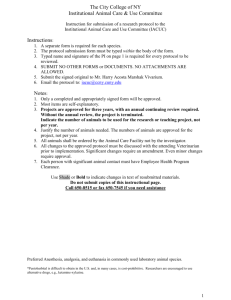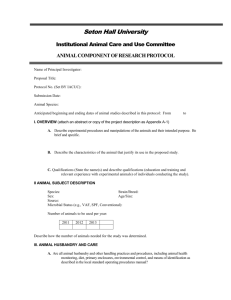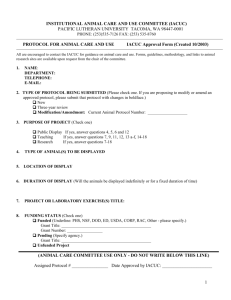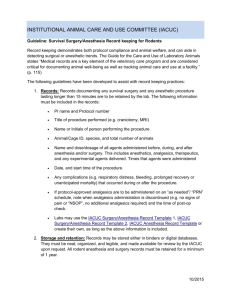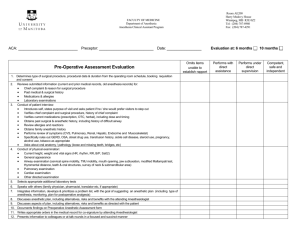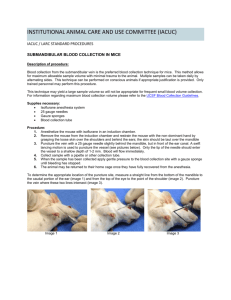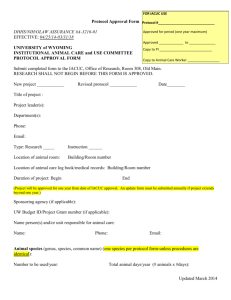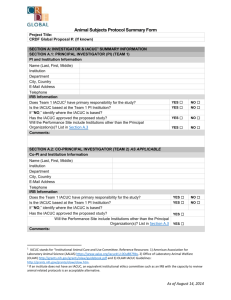NEW-IACUC-Protocol-Renewal-Form-updated 12
advertisement
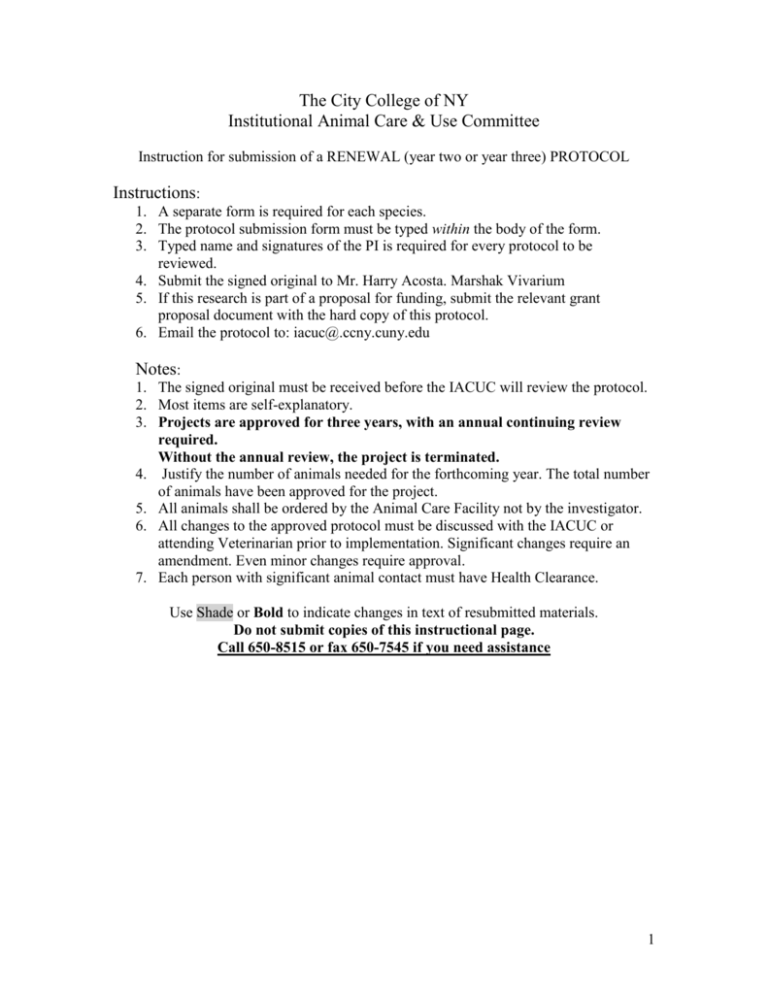
The City College of NY Institutional Animal Care & Use Committee Instruction for submission of a RENEWAL (year two or year three) PROTOCOL Instructions: 1. A separate form is required for each species. 2. The protocol submission form must be typed within the body of the form. 3. Typed name and signatures of the PI is required for every protocol to be reviewed. 4. Submit the signed original to Mr. Harry Acosta. Marshak Vivarium 5. If this research is part of a proposal for funding, submit the relevant grant proposal document with the hard copy of this protocol. 6. Email the protocol to: iacuc@.ccny.cuny.edu Notes: 1. The signed original must be received before the IACUC will review the protocol. 2. Most items are self-explanatory. 3. Projects are approved for three years, with an annual continuing review required. Without the annual review, the project is terminated. 4. Justify the number of animals needed for the forthcoming year. The total number of animals have been approved for the project. 5. All animals shall be ordered by the Animal Care Facility not by the investigator. 6. All changes to the approved protocol must be discussed with the IACUC or attending Veterinarian prior to implementation. Significant changes require an amendment. Even minor changes require approval. 7. Each person with significant animal contact must have Health Clearance. Use Shade or Bold to indicate changes in text of resubmitted materials. Do not submit copies of this instructional page. Call 650-8515 or fax 650-7545 if you need assistance 1 Preferred anesthesia, analgesia, and euthanasia in commonly used laboratory animal species Small Animals General Anesthetics Inhalants – Isoflurane in bell jar (use hood) for short procedures Mice Analgesics Sedation Euthanasia General Anesthetics Rats (bleeding etc.) Isoflurane 1.5 – 2.5% to maintain surgical anesthetic Injectables: -Pentobarbital 40-60 mg/kg IP - Ketamine 1 mL of 100 mg/mL + xylazine 0.5 mL of 20 mg/mL + saline 8.5 mL: administer 0.1 mL/30 gm body weight IP Dose Ketamine 100 mg/kg + xylazine 10 mg/kg - Avertin (tribromoethanol) 250 mg/kg IP (0.2 ml/10 g, 1.2% sol) must be stored away from light to avoid decomposition Buprenorphine 0.1 – 0.5 mg/kg SQ, IP every 6-8 hours 70% CO2 / 30% O2 to effect Ketamine 44 mg/kg + acetylpromazine 0.75 mg/kg IP 100% CO2 to effect. Note: neonates are resistant to CO2 and require longer exposure. The chamber cannot be pre-charged prior to animal placement. Inhalants – Isoflurane in bell jar (use hood) for short procedures (bleeding etc.) Isoflurane 1.5 – 2.5% to maintain surgical anesthetic Injectables: - Pentobarbital 40-60 mg/kg IP - Ketamine 50 – 70 mg/kg with xylazine 5-7 mg/kg IP Buprenorphine 0.05 mg/kg SQ for every 8-12 hours 70% CO2 / 30% O2 to effect Analgesics Sedation 100% CO2 to effect, Pentobarbital 100 mg/kg IP or IV Euthanasia General Anesthetics Inhalants: - Isoflurane 1.5 – 2.5% to maintain surgical anesthetic Rabbits Analgesics Sedation Euthanasia General Anesthetics Guinea Pigs Analgesics Sedation Euthanasia Injectables - Ketamine 35 mg/kg with xylazine 5 mg/kg IM. Incremental doses of 1/3 of the original ketamine-xylazine dose may be used to prolong anesthesia. Buprenorphine 0.03 – 0.05 mg/kg SQ every 6-12 hours Ketamine and acepromazine missed 1:1 v/v. Give 0.1 mL/kg IV Acepromazine 0.25 mg/kg IM. Pentobarbital 100 mg/kg IV Inhalants: Isoflurane/ O2 via masks 1.5 – 2.5% to maintain surgical anesthetic Injectables Ketamine 40 – 100 mg/kg with xylazine 4 – 13 mg/kg IM Pentobarbital 15 – 40 mg/kg IP Buprenorphine 0.2 – 0.8 mg/kg SQ, IM every 6-12 hours 70% CO2 / 30% O2 to effect Diazepam or midazolam 1 – 5 mg/kg IM, IP Telazol 10 – 80 mg/kg IM, IP 100% CO2 to effect, Pentobarbital 100 mg/kg IV 2 PAIN OR DISTRESS CLASSIFICATION Classification: B C D E Classification B: Animals being bred, conditioned, or held for use in teaching, testing, experiments, research, or surgery, but not yet used for such purposes. Examples: Breeding colonies of animal species that are held in legal sized caging and handled in accordance with the Guide and other applicable regulations. Breeding colony includes parents and offspring. Newly acquired animals that are held in proper caging and handled in accordance with applicable regulations. Animals held under proper captive conditions or wild animals that are being observed. Classification C: Animals upon which teaching, research, experiments, or tests will be conducted involving no pain, distress, or use of pain-relieving drugs. Examples: Procedures performed correctly by trained personnel such as the administration of electrolytes/fluids, administration of oral medication, blood collection from a common peripheral vein per standard veterinary practice or catheterization of same, standard radiography, parenteral injections of non-irritating substances. (Injections, blood sampling, tube feeding, behavioral studies w/o restraint, blood pressure measurement, anesthesia without recovery for immediate organ removal, and/or minor surgical procedures under local anesthesia e.g. biopsies, catheterization. Euthanasia performed in accordance with the recommendations of the 2000 AVMA Panel on Euthanasia, utilizing procedures that produce rapid unconsciousness and subsequent humane death. Classification D: Animals upon which experiments, teaching, research, surgery, or tests will be conducted involving accompanying pain or distress to the animals and for which appropriate anesthetic, analgesic, or tranquilizing drugs will be used. Examples: 3 Major or multiple surgery conducted under anesthesia or prolonged non-survival surgical Administration of drugs, chemicals, toxins, or organisms that would be expected to produce pain or distress but which will be alleviated by analgesics. (Freund’s adjuvant for immunization, ascites production, tumor production, etc.) Prolonged periods of physical restraint, induction of behavioral stress, induction of aggressive behavior producing self-mutilation, alteration of perceptual or motor functioning, application of noxious stimuli from which escape is impossible. Blood collection by more invasive routes such as intracardiac or periorbital collection under anesthesia. Minor surgical procedures conducted by trained personnel in accordance with standard veterinary practice such as biopsies, gonadectomy, exposure of blood vessels, chronic catheter implantation and laparoscopy performed under anesthesia. Classification E: Animals upon which experiments, teaching, research, surgery, or tests will be conducted involving accompanying pain or distress to the animals and for which the use of appropriate anesthetic, analgesic, or tranquilizing drugs will adversely affect the procedures, results, or interpretation of the research, teaching, experiments, surgery, or tests. Examples: Procedures producing pain or distress unrelieved by analgesics such as toxicity studies, microbial virulence testing, radiation sickness, and research on stress, shock, or pain. (Burn or severe trauma infliction on anesthetized animals with subsequent recovery, inducing psychotic-like behavior such as inescapable or terminal stress, use of muscle relaxants, paralytic for surgical restraint w/o anesthesia). Surgical and post surgical sequellae from invasion of body cavities, orthopedic procedures, dentistry or other hard or soft tissue damage that produces unrelieved pain or distress. Negative conditioning via electric shocks that would cause pain in humans. 4 Use a Separate Form for Each Species This form must be typed and filled in completely to be reviewed Call 650-8515or fax 650-7545 for assistance FOR IACUC USE ONLY Annual Renewal Protocol Number Review Date Approval Date 1st renewal 2nd renewal The City College of NY Institutional Animal Care & Use Committee IACUC RENEWAL PROTOCOL FORM FOR THE USE OF LIVE VERTEBRATES FOR RESEARCH OR TEACHING ANNUAL RENEWAL OF PROTOCOL NO.: First Second Section A – Investigator and Animal Use Information Principal Investigator: E-mail Address: Department: Mailing Address: Category for Pain and Distress: (required) Phone: B C D E Are you applying for, or receiving funds for the proposed experiments from external or Yes No If yes, identify the funding agency (ies) by name and I.D.# below (e.g., NHLBI, HL12345): Agencies and numbers: If relevant, your NIH assignment number must be provided. Project Title: Species common name: Number of approved animals for the project: Number of animals used to date: Number of animals to be used for the upcoming year: Investigator Assurance: 5 I will follow the ILAR Guide for the Care and Use of Laboratory Animals and the Animal Welfare Act Regulations administered by the United States Department of Agriculture. I understand that these laws and regulations are applicable to all biomedical research projects using animals that are funded through and administered by City College. As required by the Animal Welfare Act regulations, I hereby assure the IACUC that this experiment does not unnecessarily duplicate previous experiments. Furthermore, I will obtain the approval of the IACUC for any significant changes in the experiment before they are implemented. I certify that the statements herein are true, complete and accurate to the best of my knowledge. I am aware that any false, fictitious, or fraudulent statements or claims may subject me to criminal, civil, or administrative penalties. I accept responsibility for the scientific conduct of the project. I also certify that the experiments described in this protocol faithfully reflect the work proposed in the sponsored project(s) identified on page one of this application. (“Per” signatures not acceptable) Signature: Principal Investigator: _______________________________________ Date _______ Typed faculty rank and/or title of PI: Date This is an animal renewal for the above cited PROTOCOL, assigned IACUC number 1. How many animals were used on this protocol in the preceding year? 2. Justify the need for the number of animals requested for the forthcoming year. (e.g. number of animals per group), and how you arrived at this number, i.e., power analysis, or the like. 3. Describe in non-technical terms what was learned (PROGRESS REPORT) 4. Describe how the animals reacted to the procedures, were there any adverse events that affected animal use, welfare, morbidity or mortality. 5. Discuss any changes to the planned use of animals and/or objective. a. No Changes b. Changes Discuss changes here: 6. Since the last IACUC approval, have alternatives to the use of animals become available that could be substituted to achieve your specific project aims? No Yes 7. Were Radiation Safety or Research Laboratory Biosafety Committee approval needed previously? No Yes If Yes – Include current approval with this application. 6 8. New Literature search is only required for all category E protocols, and protocols involving covered species (e.g; guinea pigs, rabbits, ferrets, cats). Purpose bred mice and rats are not covered species so no new literature search is necessary for them. Are these alternatives to animals? Yes No If the procedures cause pain or distress (e.g., category D or E experiments), Federal regulations require that you provide a written narrative of the methods used to determine whether or not alternatives exist to procedures, which may cause pain or distress. The narrative should include: Two databases or other sources that must be consulted [such as, Biological Abstracts, Index Medicus, Agricola, PubMed, Current Research Information Service (CRIS) and Animal Welfare Information Center (AWIC)]; Date of the search: e.g. 02/09/2005 Years covered by the search: e.g. 1964 – 2005 Key words and/or search strategy: e.g. identify painful procedure such as: ascites, blood draw in rabbits, etc. Other methods used to determine whether there are no alternatives. Enter description of the literature search here: 8. Does this protocol involve survival surgery? No Skip to 9 (below). Yes Complete the following: Location of Surgical Site Date of IACUC inspection and approval All changes from the last approval must be discussed with the Attending Veterinarian (Dr. Popilskis): Have there been any changes in the protocol since the last approval? No Skip to 9 (below). Yes Complete the following: Discuss changes and provide addendum describing any changes from the last submission: 9. Signature: ___________________________________________________ PROTOCOL NUMBER to be renewed: PI Signature: ___________________________________________________ Date: _____ 10. Persons to be contacted in case of emergency. Name: Title: Position: Telephone number: Cell phone number: 7 11. Provide the following information for ALL RESEARCH PERSONNEL involved in animal contact: Name: Indicate the person’s role on the project? Describe the Clearances: qualifications and experience with the procedures and the Policy: species used in the experiments: Yes No Health Yes No Facility Yes No Wet Lab Yes No CITI Yes No Name: Indicate the person’s role on the project? Describe the Clearances: qualifications and experience with the procedures and the Policy: species used in the experiments: Yes No Health Yes No Facility Yes No Wet Lab Yes No CITI Yes No Name: Indicate the person’s role on the project? Describe the Clearances: qualifications and experience with the procedures and the Policy: species used in the experiments: Yes No Health Yes No Facility Yes No Wet Lab Yes No CITI Yes No 8 Indicate the person’s role on the project? Describe the qualifications and experience with the procedures and the species used in the experiments: Name: Clearances: Policy: Yes No Health Yes No Facility Yes No Wet Lab Yes No CITI Yes No Each person with significant animal contact must have Health clearance. IACUC USE BELOW THIS LINE ________________________________________________________________________ IACUC AUTHORIZATION APPROVAL: Signature: _____________________________________________________________ 9 10
